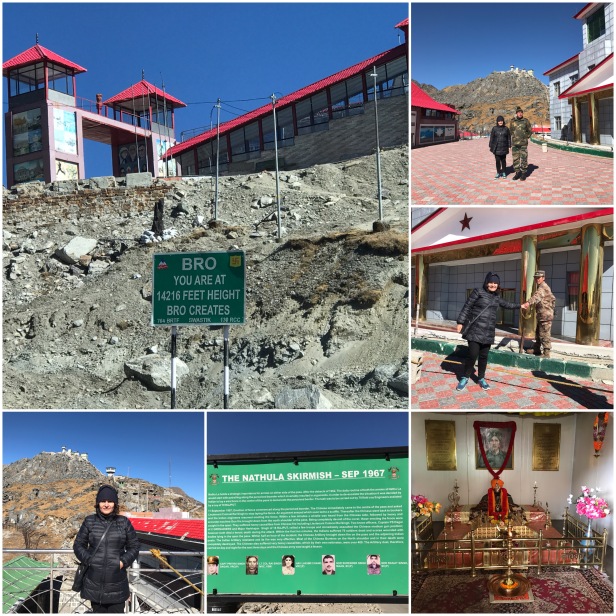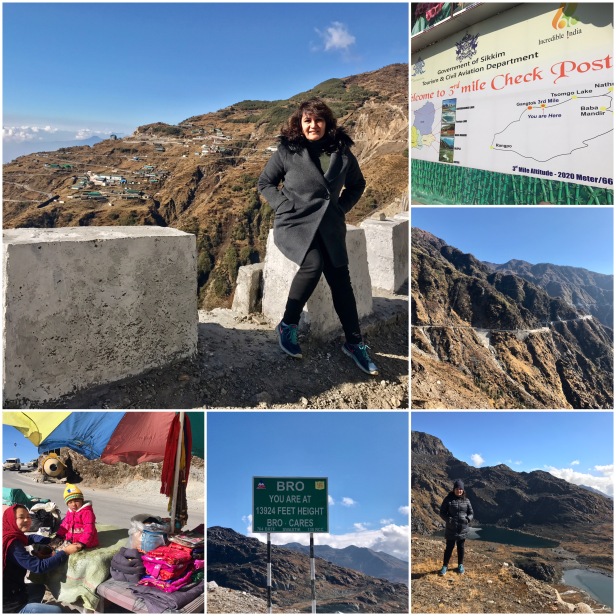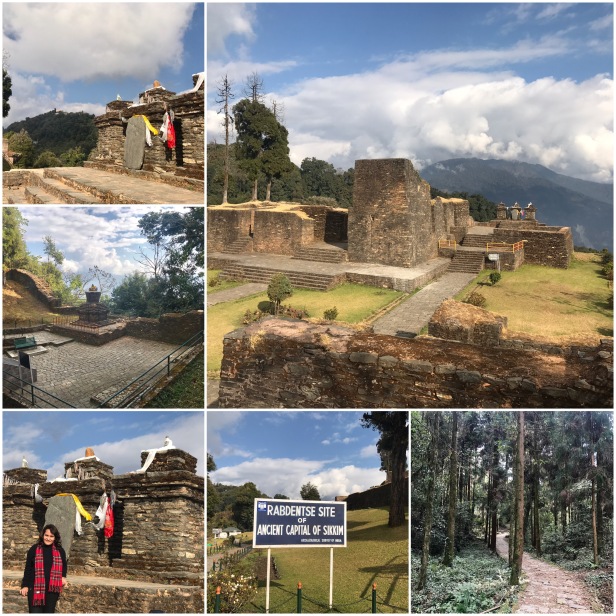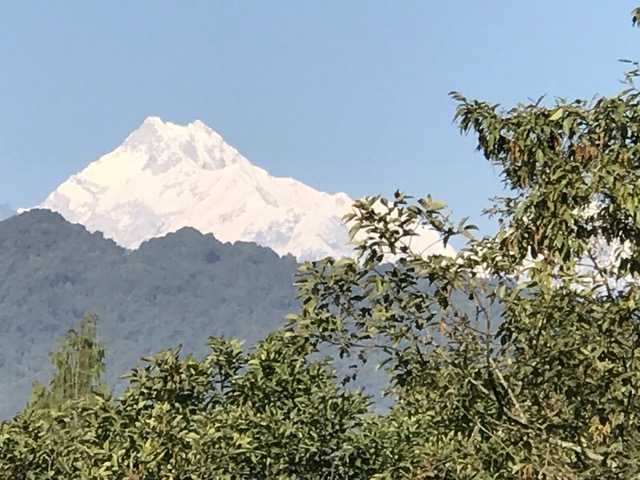My first blog post of the year and it is not about wine. That’s because Sikkim, a nature lover’s paradise, where I spent a fair amount of time in the month of December, is so much on my mind.
In any case, I have been wanting to write on travel for a long time. Since I am always on the move, it makes sense to share my travel experiences in India and across the world, with my readers.
What better way to begin with than write about this picturesque mountainous state Sikkim, situated in the North-East of India.
Photographs of the majestic Kangchenjunga (28,169ft), the third highest mountain in the world which lies partly in Sikkim India and partly in Nepal, have been enticing me since many years. But for some reasons Sikkim never figured on my travel itinerary, till my husband got posted there recently, as the Post Master General of the state.
Now was my opportunity to see this part of India. So I booked myself on an Air India flight from New Delhi to Bagdogra, the nearest airport to the capital of Sikkim, Gangtok and set out to explore this second smallest state, which become part of India as late as 15th May 1975.
Usually before setting foot in a new place, I try and find out everything there is to know through the internet. But none of the websites on Sikkim gave me information which I am sharing through this article.

The two and a half hour flight from Delhi glides along the mighty Himalayan range and on a clear day, you can get a glimpse of most ranges, including Mount Everest. Be sure to book a window seat (RowA) on the left side of the plane while flying towards the east. Internet search of the peaks prior to flying out will help you in identifying them from air. This will make your air plane ride quite interesting.

Though the distance from Bagdogra airport to Gangtok is just 125 kms, it takes four and a half hours or more to reach, due to perpetual traffic jams on NH31A and the hilly terrain. Since travel time is much more than what the distance suggests, plan ahead accordingly. This holds true for travel throughout Sikkim .
However, it is a beautiful up-hill and down-hill drive along the emerald green Teesta river and it is best to switch off from the traffic conditions, look out of the car window and enjoy the serene views. Water does have a calming effect on the senses.

There are two travel options from Bagdogra to Gangtok. Either a pre-paid private taxi from the airport or a shared taxi-jeep depending on your budget. But be prepared for some rash driving by the cabbies, which might cause a panic attack, if you are not used to traveling on hilly roads.
The entire North-East gets pitch dark by 5.30 pm during winters. In case you are traveling at this time of the year, choose your hotel wisely. If it is near MG Road, which is the throbbing heart of Gangtok and has some semblance of a night life, you may find things to do in the evening.
Otherwise, opt for a hotel which offers some activities and a meal plan (preferably dinner), so that you don’t have to go hunting for food at night. Most of the town wears a deserted look after 7.30 pm in winters.
However, the biggest advantage of visiting Sikkim during winters is the clear view of the mighty Kanchenjunga range on most days.
During summers visibility is not the best. Plus you will have to jostle for space with raucous hordes of tourists who will be arriving from all parts of India.
Monsoon (June-mid September) is not advisable either due to frequent landslides which cause road blocks and hamper travel. Plus no views.
Ideally the best time to visit Sikkim is end February to April, if you love snow. Most of the mountain lakes are frozen at this time and April end is the season for flowers. October to December is best for the views, though you will not find any snow, except on the distant peaks.
If you have limited time, I would say two days is enough for Gangtok, for local sight-seeing. You can look up any Sikkim tourism website and pick out the spots. Local taxis are the best option here. They operate on a point system (1 point = one tourist spot) and not by meter.
I would recommend walking if any of the tourist spots are within a few kilometres of your hotel or place of stay.
Not to be missed are Enchey and Rumtek Monateries, Tsuklakhang Royal Chapel, Hanuman Tok Temple (for the best view of the Kanchenjunga). You can avoid the much hyped Tashi View Point (8 kms from Gangtok town) as the nearby Ganesh Tok temple has better views.

The most important thing to remember is that the best time to view the magnificent Himalayan ranges is early morning between 6 am-10.30 am. So plan your day accordingly.
Other than the picturesque views, what strikes you most in Gangtok, is the lack of incessant honking (horns are illegal within the city limits) and the cleanliness. There is a hefty fine of Rs 5000 for littering. This is a pleasant change from most Indian cities and I really wish it could be replicated in the rest of India too.
The people of Sikkim, a mix of Gorkhas (Nepalese), Lepcha and Bhutias are very friendly, helpful and courteous. Since majority follow Buddhism, they are gentle by nature and non-aggressive. Another delightful change from North India.
Practically everyone who visits Gangtok makes a day trip to India’s Border Post with China, Nathu La, a mountain pass connecting Sikkim with China’s Tibet Autonomous Region. Situated at an altitude of 14,216 ft and just 55 kms from Gangtok, Nathu La forms part of the ancient Silk Road and is one of the three open trading border posts between India and China.
A dampener for foreign nationals is that only Indians are allowed to go till Nathu La and that too after applying for an Inner Line Permit. In fact, most places in Sikkim fall under restricted area requiring a permit to visit. So check before hand if the place you intend to visit requires a special permit or not and carry enough passport size photographs and photostat copies of your Aadhar or Election Card.
Nathu La is closed for all tourists on Mondays and Tuesdays. So keep that in mind too.

Tsomgo or Changu Lake (40 kms from Gangtok at an altitude of 12,700 feet) which is on the way to Nathu La is however open to all tourists, Indian and foreign. But you need a separate Permit for this, other than the one for Nathu La, though both fall on the same route.

It is a spectacular drive on dizzying mountain roads. However, since you will be climbing from 5200 ft to 14,000, in just a matter of two hours without acclimatization, you are bound to suffer from high altitude sickness, like I did. Symptoms are a blinding headache and nausea and the only cure is slow descent and adequate rest.

One place which should be a must on your itinerary if you are traveling to Sikkim is Pelling (7,200ft) in West Sikkim. Though just 115 kms away from Gangtok, it takes more than fours hours to reach as the road is non-existent. It is practically a dirt track.
But then again, switch off from the horrendous road conditions, concentrate on the beautiful poinsettias and numerous waterfalls along the way and take in the magnificent views. If only Sikkim had better roads was my constant lament throughout my travels.
Do stop at the picturesque tourist town, Ravangla in South Sikkim, about 65 kms from Gangtok, on the way to Pelling and visit Tathagata Tsal or Buddha Park as it is known as.

In my opinion, the best place to stay in Pelling, is the beautiful heritage resort, Elgin Mount Pandim, which is within walking distance of Pemayangstse Monastery and about 8kms from Pelling town. You get spectacular views of Kanchenjunga range from here, provided the mountain wants to reveal itself to you. Most times it is shrouded in clouds.

Must see place situated very close to Pelling is Rabdenste Ruins, the second capital of the Chogyals (temporal and religious rulers of Sikkim from 1642-1975).

If you don’t have much time, avoid going to Yuksom (40 kms from Pelling), the starting point for Dzongri and Goecha La Treks to Kanchenjunga Base Camp. There is nothing much to this town except Norbugang, the coronation site of Phuntsog Namgyal, the first Chogyal of Sikkim. Yuksom was the first capital of Sikkim established in 1642 AD.

I was also disappointed by the much revered Khecheopalri Lake (34 kms to the northwest of Pelling) as the scenery was not inspiring. So unless you have a religious bent of mind, save some precious hours and spend more time in Pelling. The drive to and from Pelling to Khecheopalri takes nearly two hours on narrow hilly roads.

My staple diet during my stay in Sikkim was local Tibetan dishes momos and thukpa which you find everywhere, from roadside stalls to restaurants. I also tried Nepali cuisine at Thakali on MG Road Gangtok, which has many good restaurants and bars.

Sikkim is an organic state and most local produce like fruits and vegetables is sold along the highways. You must try the fruits especially oranges and kiwis.
Also don’t forget to carry back some Dalle Chili Pickle and Chilli Paste with you. Though not as potent as Bhut Jolokia (ghost pepper), world’s hottest chilli, it does pack quite a punch.

Meanwhile, I am still in a Sikkim state of mind and dream of exploring other parts of this beautiful heavenly state. Would love to see Yumthang Valley, Lachung, Lachen & Gurudongmar Lake in North Sikkim, if I get a chance to visit again.
By: Lavina Kharkwal
All photos posted here are clicked by me except the ones in which I am there.

So well written Dearest Lavina! I felt as if I was traveling Sikkim with you. Thank you for keeping your wonderful articles posted here. It is really saddening to know about poor roads and permit Raj in Sikkim. But being a hilly and a boarder state has its implications. Thanks again! And please keep sharing 🙂
LikeLike
Very well put together. I lived for 2 years near Nathula and flew helicopters over Sikkim for 3 years. Been all over the area. My personal favourite area is Yumthang. It’s really beautiful in April May as also in autumn.
LikeLike
Very smooth reading.Enjoyed every bit.
LikeLike
Wonderful post. This blog has an amazing information about the destination places beautiful visiting spot and captures very impressive photos.
LikeLike